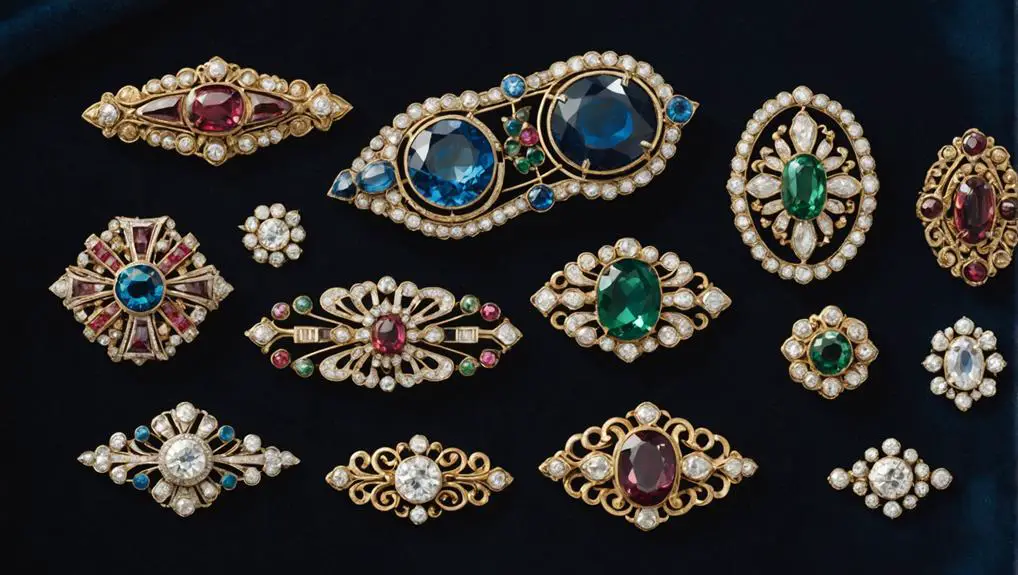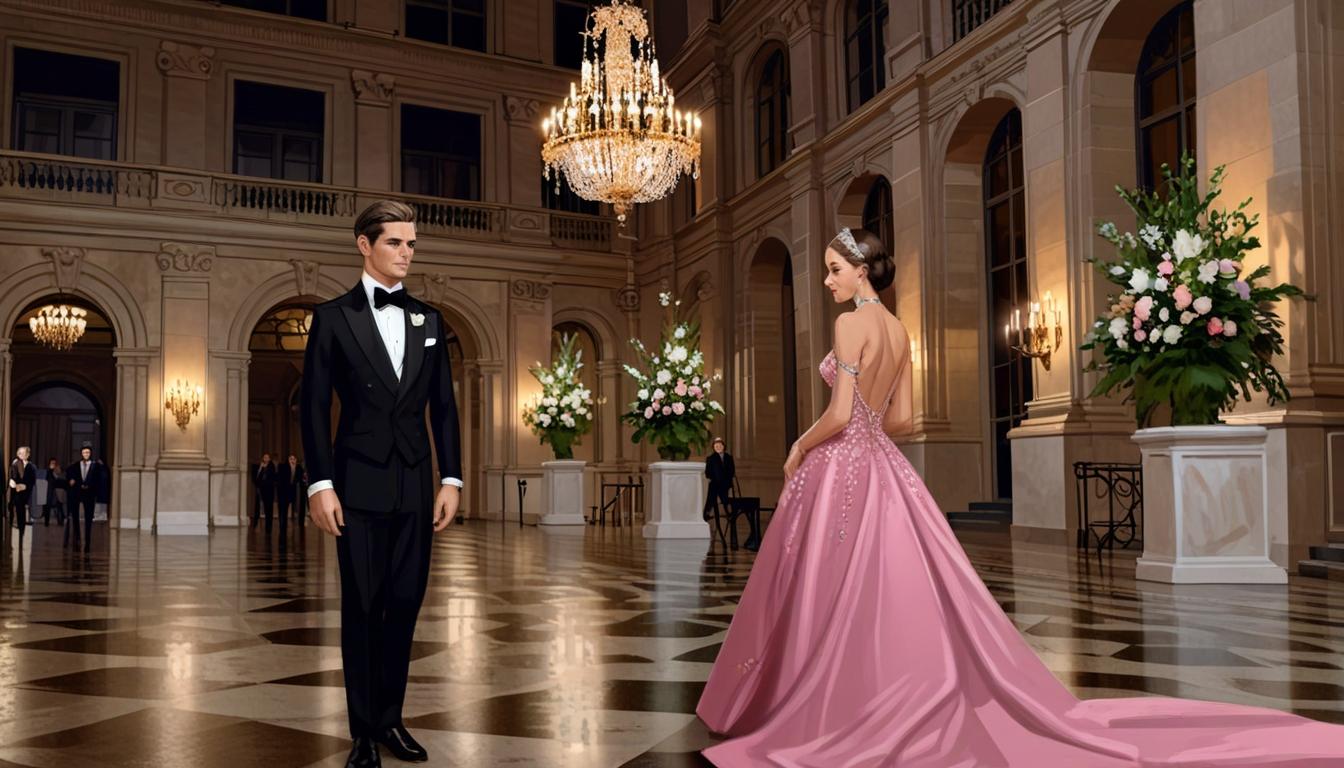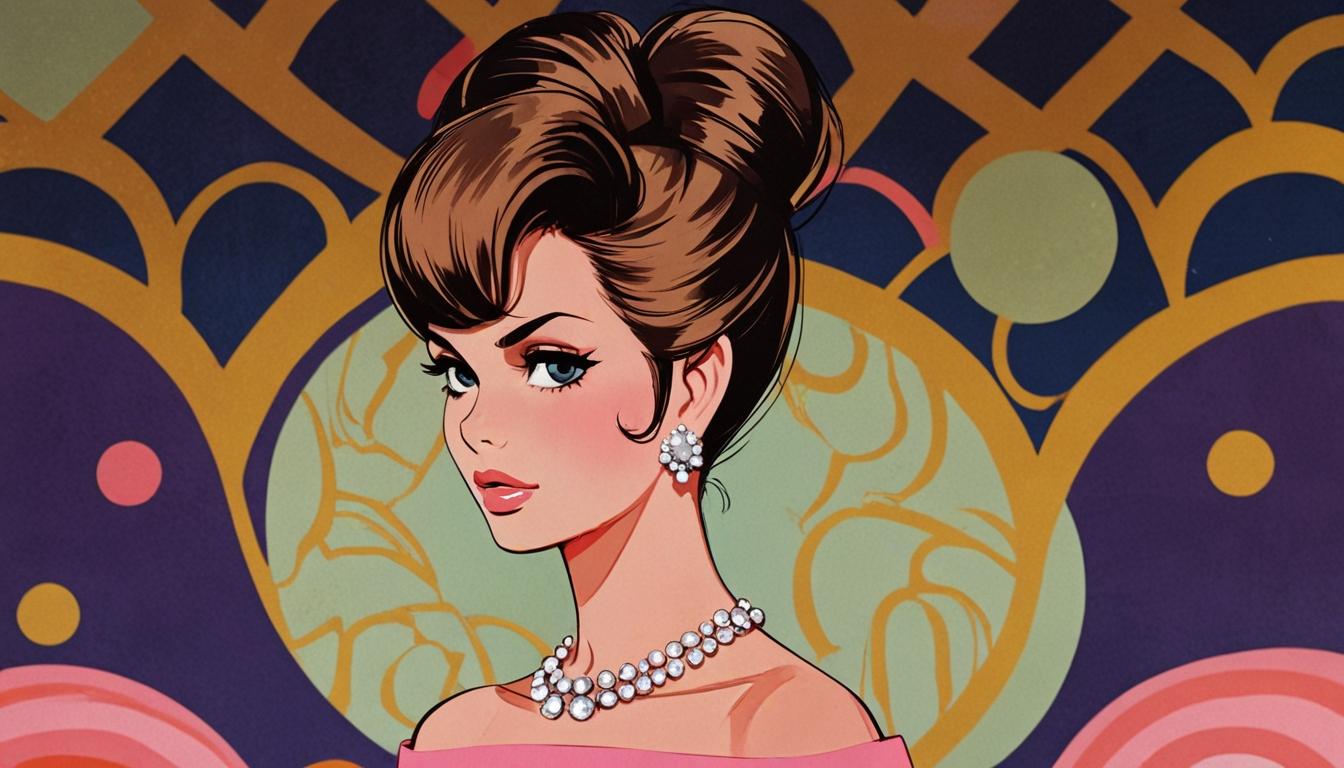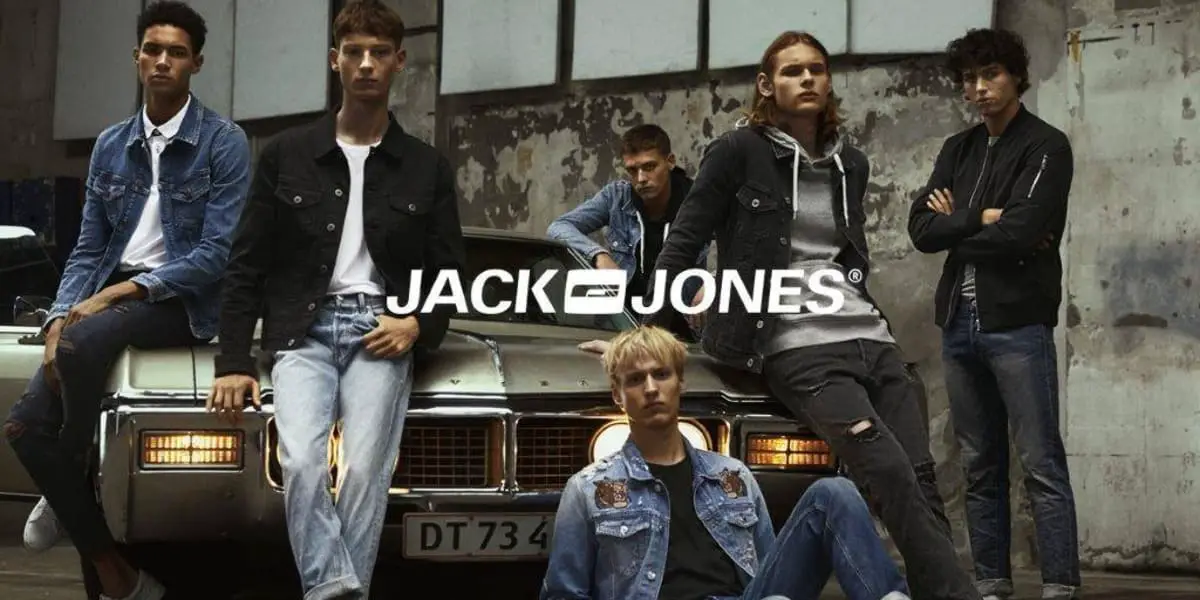In the 1930s, women's brooches evolved into bold fashion statements that combined vibrant colors and striking geometric shapes. The Art Deco movement greatly influenced these designs, celebrating materials like platinum, diamonds, and Bakelite. Iconic designers such as Cartier and Van Cleef & Arpels produced exquisite pieces featuring intricate craftsmanship and whimsical motifs, reflecting nature and modernism. Floral patterns and detailed metalwork became popular, marking brooches as status symbols. As you explore this rich era, you'll discover how craftsmanship and artistic expression shaped these wearable works of art and their lasting impact on fashion.
Evolution of 1930s Brooch Styles
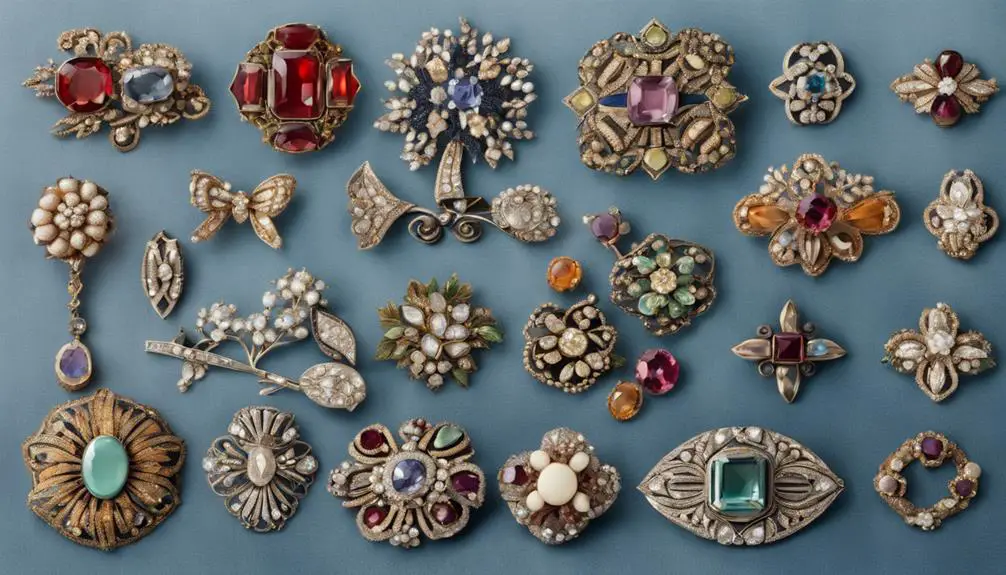
The evolution of brooch styles in the 1930s reveals a fascinating interplay between artistic innovation and societal change. This decade marked a significant departure from previous styles, as brooches began to embrace the bold geometric shapes and vibrant colors characteristic of Art Deco. You'd notice how these designs often showcased high-quality materials like platinum and diamonds, reflecting both luxury and the era's artistic aspirations. Many vintage clothing pieces from this era, such as those featuring vintage labels, further highlight the craftsmanship and attention to detail that were integral to the fashion of the time.
Floral motifs gained popularity during this time, crafted from enamel, gold, and Bakelite, mirroring society's growing fascination with nature and elegance. The intricate detailing of 1930s brooches set them apart, featuring mixed metals and gemstones like garnet and amethyst that emphasized craftsmanship. Additionally, many brooches incorporated movable elements, adding dynamic flair and enhancing their wearability. However, the economic challenges of the Great Depression shifted the focus toward affordable elegance. This led to a rise in costume jewelry, allowing women to express style without financial strain. As a result, 1930s brooches became symbols of resilience, merging artistic creativity with the practical needs of a society in flux. Through these brooches, you can trace not just fashion trends, but also the spirit of an era.
Materials Used in Brooch Design
Brooch designs of the 1930s are a demonstration of the era's rich material palette, reflecting both luxury and innovation. You'll notice how these pieces often feature exquisite materials like diamond, garnet, gold, and platinum, emphasizing the elegance that defined the decade. Art Deco brooches, in particular, showcased the era's penchant for boldness, using mixed metals to create intricate and striking patterns.
In addition to traditional materials, designers embraced Bakelite, a synthetic resin that introduced vibrant colors and playful shapes to the brooches. This innovation allowed for a broader range of designs, appealing to the whims of contemporary fashion. High-quality gemstones, such as amethyst and onyx, were also prevalent, enhancing the visual appeal and intrinsic value of these accessories.
The craftsmanship of 1930s brooches is remarkable, characterized by detailed metalwork that often included filigree and layered designs. Such techniques not only displayed the artisans' skills but also highlighted the era's commitment to quality and artistry. As you explore these brooches, you'll appreciate how each material contributed to the overall narrative of style and sophistication during this transformative decade.
Iconic Designers of the Decade

While exploring the world of 1930s jewelry, you'll encounter a plethora of iconic designers who shaped the era's aesthetic through their innovative brooch creations. The Art Deco Period brought forth luxurious designs, with Cartier leading the charge. Their Art Deco Sioux Clip Brooch from 1938 exemplifies intricate craftsmanship paired with opulence.
Van Cleef & Arpels emerged as a key player, infusing floral motifs and vibrant gemstones into timeless pieces that dazzled the public. Meanwhile, Trifari's Alfred Philippe introduced playful designs like the mini turtle brooch, which became a signature of the brand's whimsical style.
Marcel Boucher gained recognition for his enamel pave lamb brooch, combining high-quality craftsmanship with a touch of whimsy. Sandor Goldberg's bouquet brooches also gained popularity, showcasing an appreciation for detailed artistry.
| Designer | Notable Brooch | Style |
|---|---|---|
| Cartier | Art Deco Sioux Clip Brooch (1938) | Luxurious and intricate |
| Van Cleef & Arpels | Floral Motif Brooch | Timeless and vibrant |
| Trifari | Mini Turtle Brooch | Playful and charming |
| Marcel Boucher | Enamel Pave Lamb Brooch | Whimsical craftsmanship |
Popular Themes and Motifs
Elegance and creativity define the popular themes and motifs of 1930s brooches, where nature-inspired designs flourished alongside geometric shapes. You'll notice floral motifs prominently featured, reflecting the Art Deco movement's embrace of organic forms. This period also saw a rise in geometric shapes and bold patterns, showcasing modernist influences and the striking use of contrasting colors, often achieved with enamel and gemstones.
Animal motifs became fashionable, with intricate representations of birds, insects, and beloved pets adorning brooches. These pieces often utilized materials like Bakelite and metal, emphasizing the craftsmanship of the era. Whimsical elements, such as playful charms and figurative designs, highlighted a love for novelty and artistic expression in jewelry.
Every brooch made during this time was a demonstration of significant craftsmanship, utilizing high-quality materials like diamonds, gold, and platinum. This not only enhanced the elegance of each piece but also its prestige. As you explore these brooches, you'll appreciate how each motif tells a story, capturing the spirit of the 1930s while showcasing the artistry that defined women's fashion in that vibrant decade.
Brooches as Fashion Statements
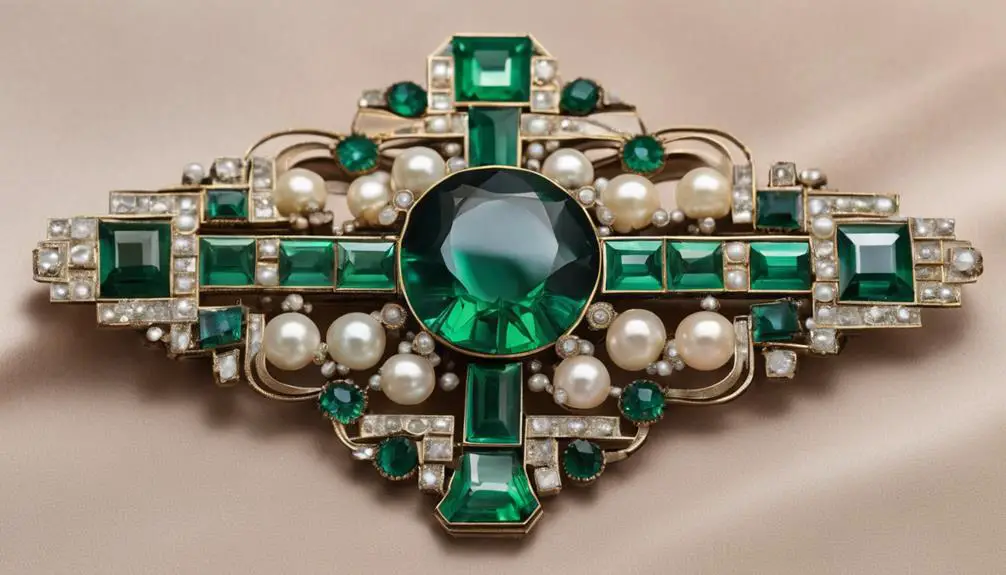
The 1930s marked a pivotal time when brooches evolved from mere accessories into bold fashion statements that defined personal style. You'd find women using brooches to accentuate their outfits, showcasing a unique blend of artistry and individuality. Designers embraced bold colors and intricate craftsmanship, frequently incorporating materials like diamonds, gold, and enamel into their creations.
Floral, geometric, and whimsical motifs dominated the brooch scene, echoing the artistic movements of the era, such as Art Deco and Art Nouveau. These designs not only served aesthetic purposes but also became symbols of social status. Women sought unique and collectible pieces, understanding that a well-chosen brooch could elevate their entire ensemble.
The popularity of brooches during this decade was solidified by their prominent presence in high-profile fashion shows. Here, they influenced emerging trends and cemented their place in women's fashion history. As you explore this era, it's clear that brooches were more than just decorative items; they were essential expressions of identity and taste, allowing women to communicate their style and sophistication in a rapidly changing world.
Notable Collectible Pieces
Brooches from the 1930s stand out as remarkable collectibles, each piece telling a story through its design and materials. One iconic example is the Cherry Red Bakelite brooch, showcasing fern inclusions that reflect the era's vibrant aesthetic. Similarly, the Trifari Clip-Mates ribbon brooch, with its intricate rhodium-plated design, captures the innovative spirit of late 1930s craftsmanship.
As you explore these collectibles, consider the luxurious Mother of Pearl Goddess brooch, attributed to the renowned designer René Le Marchand for Schiaparelli. This piece encapsulates the opulent fashion trends of the time. You'll also notice a shift towards more organic designs in the early 1940s with hand-carved wooden flower brooches, indicating a growing appreciation for nature-inspired themes.
Not to be overlooked are the sterling silver leaf brooches by Hector Aguilar from circa 1940. These pieces exemplify bold artistic expression and high-quality materials, making them highly sought after by collectors. Each of these notable pieces not only enhances your collection but also serves as a reflection of the artistic evolution and cultural context of jewelry design in the 1930s.
Care and Preservation Tips
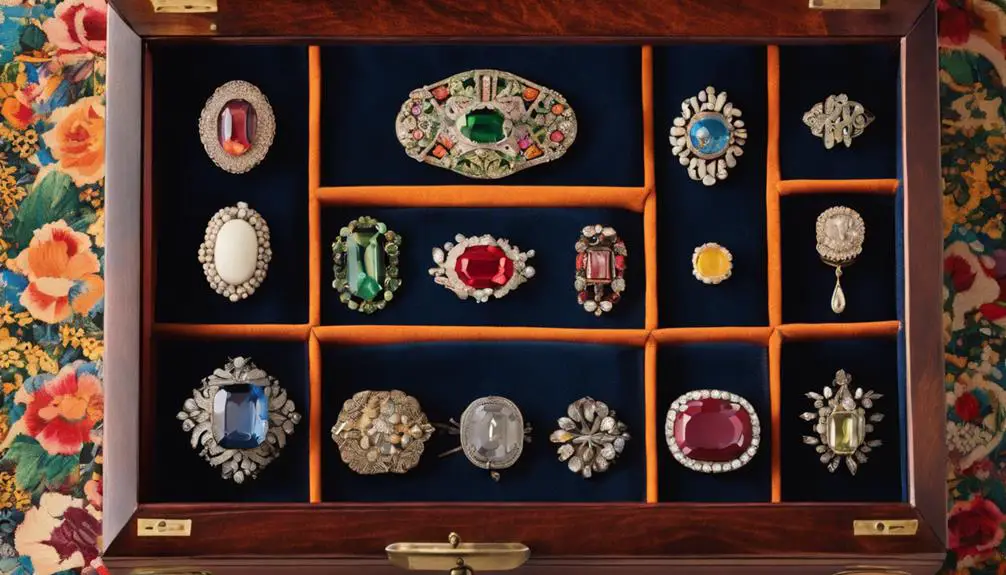
Proper care and preservation of your 1930s brooches is essential to maintaining their beauty and value over time. By following these simple yet effective tips, you can guarantee your vintage treasures remain in excellent condition.
- Store Properly: Keep your brooches in a cool, dry place, away from direct sunlight. This prevents discoloration, particularly for delicate materials like celluloid or enamel.
- Gentle Cleaning: Use soft cloths to clean your brooches. Avoid harsh chemicals that can damage the finish or gemstones, especially rhinestones and pearls, which are prevalent in 1930s designs.
- Prevent Tarnishing: For metal brooches, apply a light coat of wax or specialized jewelry polish. This is particularly important for sterling silver pieces to maintain their luster.
- Avoid Harsh Products: Steer clear of exposing your brooches to perfumes, lotions, or hairsprays. These can cause chemical reactions that may tarnish or corrode the materials.
Regularly inspect your brooches for loose stones or damaged settings. Addressing these issues promptly will help preserve their unique craftsmanship and value, guaranteeing they continue to be cherished for years to come.
Influence of Art Deco
How did the Art Deco movement shape women's brooches in the 1930s? The emergence of Art Deco transformed these accessories into statements of modernity and sophistication. You'd notice that Art Deco brooches were characterized by their bold geometric shapes and vibrant colors, often made from luxurious materials like diamonds and platinum. This period celebrated innovative techniques, incorporating enamel work and synthetic stones, which showcased significant advancements in jewelry craftsmanship.
Notable jewelers such as Cartier and Van Cleef & Arpels played pivotal roles in this movement, producing iconic pieces that remain highly coveted. The motifs commonly found in these brooches—reflecting nature, architecture, and abstract forms—captured the spirit of the era and appealed to women seeking elegance in their fashion choices. The intricate detailing and playful designs of Art Deco brooches offered a unique blend of artistry and luxury, aligning perfectly with the desires of 1930s women.
Ultimately, the influence of Art Deco not only redefined the aesthetic of brooches but also solidified their status as essential accessories for those who embraced the elegance and sophistication of the time.
Modern Interpretations of Vintage Brooches

Vintage brooches have seen a remarkable revival in modern fashion, with designers skillfully blending the bold colors and geometric patterns of 1930s Art Deco styles into contemporary pieces. This resurgence taps into a broader appreciation for vintage aesthetics, allowing you to celebrate the past while remaining stylish today.
- Reimagined Motifs: Many brooches now reinterpret classic floral and animal designs, utilizing modern techniques like laser cutting and 3D printing to enhance their intricacy.
- Limited Editions: Contemporary jewelry brands are creating limited-edition pieces that echo 1930s craftsmanship, often using high-quality materials like gold, silver, and gemstones to appeal to discerning consumers.
- Layering Trends: The trend of layering multiple brooches is reminiscent of 1930s styles, giving you the freedom to personalize your look with vintage-inspired pieces that tell your unique story.
- Growing Market: The increasing interest in vintage fashion has led to a thriving market for reproductions and reinterpretations, attracting both collectors and new enthusiasts keen on vintage aesthetics.
Frequently Asked Questions
How Do You Identify Vintage Brooches?
To identify vintage brooches, you should examine materials, look for hallmarks, assess craftsmanship, evaluate design styles, and check for signs of wear. Each detail can reveal the piece's age and authenticity.
What Year Were Brooches Popular?
Brooches were particularly popular during the 1930s, reflecting bold design trends and individual style. You'll notice their vibrant colors and unique materials, showcasing the creativity of that era's jewelers, making them timeless fashion statements.
Did They Wear Brooches in the 1920s?
Yes, you'd find women wearing brooches in the 1920s. These accessories featured geometric designs and bold colors, often made from rhinestones and gold, enhancing their outfits while reflecting the era's vibrant, modern aesthetic.
What Are the Oldest Types of Brooches?
The oldest types of brooches, known as fibulae, date back to around 3000 BC. They functioned as clothing fasteners, evolving over centuries with styles like Bow and Trumpet emerging in later centuries, showcasing craftsmanship advancements.
